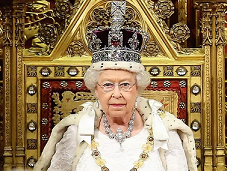«¡The Queen is dead,
Long Live the King!»
London, Sept. 8 (DP.net).– Elizabeth II, the British monarch, has completed her  splendid reign. After Louis XIV, who ruled France for 72 years, her term on the throne is the second-longest in history. Following the passing of her father, King George VI, and five years after their Westminster Abbey wedding to Prince Philip, commonly known as the Duke of Edinburgh, Queen Elizabeth II came to the throne in 1952. Eight grandchildren, 12 great-grandchildren, and four children were born to her and Prince Philip. She served as a monarch for 70 years.
splendid reign. After Louis XIV, who ruled France for 72 years, her term on the throne is the second-longest in history. Following the passing of her father, King George VI, and five years after their Westminster Abbey wedding to Prince Philip, commonly known as the Duke of Edinburgh, Queen Elizabeth II came to the throne in 1952. Eight grandchildren, 12 great-grandchildren, and four children were born to her and Prince Philip. She served as a monarch for 70 years.
With the assistance of her family, Queen Elizabeth served as the head of state in the United Kingdom and many other Commonwealth nations. She made historic travels to places like China, the Middle East, and the Vatican while fostering ties with longtime friends like the United States. She hosted some 120 state visits, including her renowned state banquets at Buckingham Palace.
The queen had delegated one of her most important public duties to Prince Charles in May, having him preside over the State Opening of Parliament and delivering the Queen’s Speech laying out the government’s legislative program. The event is a symbol of the monarch’s constitutional role as head of state and is accompanied by centuries of tradition designed to demonstrate the strength of Britain’s political institutions.
"I cannot lead you into battle," the Queen, summing up her role in a 1957 Christmas broadcast, once told her subjects. "I do not give you laws or administer justice, but I can do something else: I can give my heart and my devotion to these old islands and to all the peoples of our brotherhood of nations."
The announcement of her death came a day after the Queen canceled a meeting of her Privy Council and was told to rest. On Tuesday, September 6, she presided over the ceremonial handover of power to new Prime Minister Liz Truss at her summer residence at Balmoral Castle in Scotland.
The royal family's plan, dubbed "Operation London Bridge," lays out in minute detail what is going to happen in the first 10 days following the monarch's passing on September 8, 2022, in Scotland at the age of 96. Her private secretary, Sir Edward Young, will be the first official to convey the news (apart from her relatives and medical team), per The Guardian. From there, Young will contact the Prime Minister, Elizabeth Truss, giving the code phrase "London Bridge is down" to signal her death.
From the Foreign Office's Global Response Centre, the news of the queen's death will go out to "the 15 governments outside the UK where the Queen is also the head of state, and the 36 other nations of the Commonwealth for whom she has served as a symbolic figurehead."
The Prime Minister will be the first government official to make a statement. The prime minister will then meet with the new monarch, Prince Charles, and he would deliver a speech to the nation at 6 p.m. on the evening following Queen Elizabeth's death.
It is appropriate to also remember the devotion and attachment of the royal family to the country in which they reigned: In September 1939, Britain entered the Second World War. Lord Hailsham suggested that Princesses Elizabeth and Margaret should be evacuated to Canada to avoid the frequent aerial bombings of London by the Luftwaffe. This was rejected by their mother, who declared, "The children won't go without me. I won't leave without the King. And the King will never leave."
At the end of the war in Europe, on Victory in Europe Day, Elizabeth and Margaret mingled incognito with the celebrating crowds in the streets of London. Elizabeth later said in a rare interview, "We asked my parents if we could go out and see for ourselves. I remember we were terrified of being recognized... I remember lines of unknown people linking arms and walking down Whitehall, all of us just swept along on a tide of happiness and relief."
 In 1957, Elizabeth made a state visit to the United States, where she addressed the United Nations General Assembly on behalf of the Commonwealth. On the same tour, she opened the 23rd Canadian Parliament, becoming the first monarch of Canada to open a parliamentary session
In 1957, Elizabeth made a state visit to the United States, where she addressed the United Nations General Assembly on behalf of the Commonwealth. On the same tour, she opened the 23rd Canadian Parliament, becoming the first monarch of Canada to open a parliamentary session
From April to September 1982, the Queen's son, Prince Andrew, served with British forces in the Falklands War, for which she reportedly felt anxiety and pride.
In the wake of the Coalition victory in the Gulf War, the Queen became the first British monarch to address a joint meeting of the United States Congress in May 1991.
Elizabeth addressed the UN General Assembly for a second time in 2010, again in her capacity as Queen of all Commonwealth realms and Head of the Commonwealth. The UN Secretary-General, Ban Ki-moon, introduced her as "an anchor for our age". During her visit to New York, which followed a tour of Canada, she officially opened a memorial garden for British victims of the September 11 attacks.
Comments powered by CComment